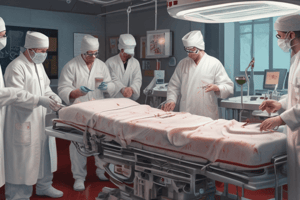Podcast
Questions and Answers
Which type of patient is at highest risk for developing a transfusion reaction?
Which type of patient is at highest risk for developing a transfusion reaction?
- Lymphopenic patients (correct)
- Patients with a history of allergies
- Patients with a history of heart disease
- Patients with chronic kidney disease
What is the most common sign or symptom of a transfusion-associated sepsis (TAS) reaction?
What is the most common sign or symptom of a transfusion-associated sepsis (TAS) reaction?
- Nausea and vomiting
- Chest pain
- Fever and rigors (correct)
- Shortness of breath
Which of the following is an example of an acute transfusion reaction?
Which of the following is an example of an acute transfusion reaction?
- Delayed serological transfusion reaction
- Febrile non-hemolytic transfusion reaction
- Transfusion-related acute lung injury (correct)
- Post-transfusion purpura
What is the primary cause of a transfusion-associated circulatory overload (TACO) reaction?
What is the primary cause of a transfusion-associated circulatory overload (TACO) reaction?
What is the long-term complication of repeated red blood cell transfusions?
What is the long-term complication of repeated red blood cell transfusions?
Which type of transfusion reaction typically develops after 24 hours post-transfusion?
Which type of transfusion reaction typically develops after 24 hours post-transfusion?
Which of the following is a clinical sign or symptom of a transfusion reaction?
Which of the following is a clinical sign or symptom of a transfusion reaction?
Which of the following is a sign or symptom of iron overload from repeated transfusions?
Which of the following is a sign or symptom of iron overload from repeated transfusions?
Which laboratory finding is associated with acute transfusion reactions?
Which laboratory finding is associated with acute transfusion reactions?
What is the recommended first-line therapy for an acute transfusion reaction?
What is the recommended first-line therapy for an acute transfusion reaction?
What is the primary pathophysiology underlying transfusion reactions?
What is the primary pathophysiology underlying transfusion reactions?
Which of the following is a recommended step in the clinical workup of a suspected transfusion reaction?
Which of the following is a recommended step in the clinical workup of a suspected transfusion reaction?
What are the two types of Hemolytic Transfusion Reaction (HTR) categorized based on timing?
What are the two types of Hemolytic Transfusion Reaction (HTR) categorized based on timing?
What is the primary site where Hemolysis occurs in Intravascular HTR?
What is the primary site where Hemolysis occurs in Intravascular HTR?
Which laboratory investigation is indicative of Urticarial (Allergic) Transfusion Reaction?
Which laboratory investigation is indicative of Urticarial (Allergic) Transfusion Reaction?
What does the presence of pyrogens from WBCs lead to in the recipient during a Hemolytic Transfusion Reaction?
What does the presence of pyrogens from WBCs lead to in the recipient during a Hemolytic Transfusion Reaction?
How can Intravascular HTR be masked if anti-pyretics are used before starting transfusion?
How can Intravascular HTR be masked if anti-pyretics are used before starting transfusion?
What is a recommended therapy to prevent Hemolytic Transfusion Reactions?
What is a recommended therapy to prevent Hemolytic Transfusion Reactions?




